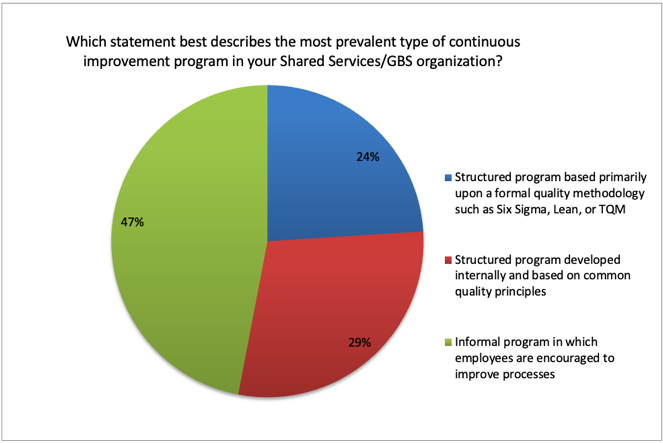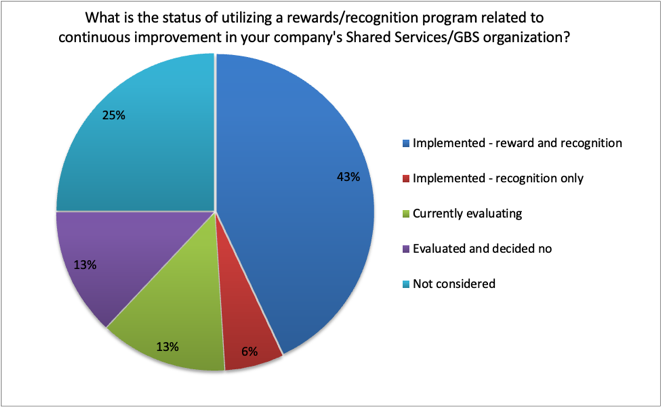Formal Continuous Improvement Programs in Shared Services/GBS
Introduction
While many companies realize significant savings when first transitioning to Shared Services, uncovering additional savings opportunities can be a challenge without the proper focus. One attribute of many successful Shared Services operations is a well-established Continuous Improvement program that is ingrained into the culture of the operation. The topic of Continuous Improvement (or Continuous Process Improvement) remains as one of the most popular in the world of Shared Services/GBS, and for good reason. The strong performance results companies have experienced have been impressive, and for many, having an active Continuous Improvement program has been a significant factor in achieving superior results.
When implementing a Continuous Improvement in a Shared Services/GBS environment, three different approaches are typically taken. First is a structured program based upon a formal quality methodology, such as Lean, Six Sigma, TQM, etc. However, many Shared Services organizations either don’t have access to that type of quality program or have decided that they prefer something less formal and structured. As a result, they develop their own approach to Continuous Improvement based on those tested methodologies, but with their own slant on how they should be applied. Finally, some companies keep the entire Continuous Improvement effort very informal by encouraging employees to improve processes, without the traditional tools and structure of a formal quality program.
As discussed below, the impact of having a formal Continuous Improvement program can be significant, with the most success possible when the improvement efforts combine all three elements: 1) a formal methodology, 2) shaped with an appreciation of the company culture, and 3) with a broad and extensive number of employees who have both the required training and passion to lead and/or participate in Continuous Improvement projects.
Company Experience
On a Peeriosity-100 Peercast, a global company with over $25B in annual revenue, discussed their insights for successfully deploying and sustaining a Continuous Improvement Program.
The objectives of their Continuous Improvement Program are:
- Enable everyone in the global organization to recognize and implement opportunities for improvement.
- Challenge everyone to focus on adding and eliminating work steps that do not add value; look at processes end-to-end; stop and fix processes when errors occur; and always speak with data and fix root causes.
- Encourage learning through trial and error, with constant steps towards perfection.
The support structure for Continuous Improvement efforts starts with a wide base, where every team member is encouraged to think of themselves as a Continuous Improvement Champion, who has training to be able to identify and implement improvements. To support this foundation there are more than 1,100 graduates of their Continuous Improvement Academy with yellow belts, with over 50 additional team members who are coach trained (green belts). At the next level are Continuous Improvement Coaches, with 1 coach per 15 employees who take a lead role in driving Continuous Improvement within a department. At the top level are senior leaders who set the direction and reinforce a culture of Continuous Improvement. A central Continuous Improvement team of black belts supports every level, with Continuous Improvement initiatives that are both tops-down and bottoms-up.
Polling Results Review
A Peeriosity-100 poll was created to learn more about Peeriosity-100 member companies’ approaches to deploying a Continuous Improvement methodology within Shared Services/GBS. The most prevalent approach, at 47% of responding member companies, is to use an informal program in which employees are encouraged to improve processes. Another 29% use a structured program developed internally and based on common quality principles and the remaining 24% use a structured program based primarily upon a formal quality methodology. Here are the details:

The second polling question addressed the issue of utilizing a rewards & recognition program in association with the Continuous Improvement efforts in Shared Services. Looking at the poll results, 49% of Peeriosity-100 member companies have implemented this practice with 43% using both recognition and financial rewards and 6% focusing only on recognition. An additional 13% are currently evaluating creating a reward and/or recognition program, 13% evaluated the idea and decided no, and 25% have not considered the idea.
Clearly, when properly implemented and administered, a rewards & recognition program can provide additional energy and excitement around the Shared Services process improvement efforts and will help individual employees to feel that they are part of something much bigger than just their individual role.
 .
.
Here are some of the comments from members:
- We do something called the Finance Impact awards but that is annual not continuous throughout the year.
- We have a formal improvement submission/review process, but the identification is the responsibility of the individuals and not based upon quality principles or methodology; our focus is on value to the business. We don’t specifically reward improvement but do occasionally conduct competitions with one off rewards. Also, the submission of improvements is built into objective setting.
- We have an expectation to continually improve and formal process to capture and assess ideas. Rewards can be either financial or recognition.
- We continue to drive CI in our existing processes across GBS and BU.
- Process improvement is tied to our core values, which is the foundation for our recognition program.
Closing Summary
Achieving improvements in performance for Shared Services/GBS includes a mix of many factors including sourcing decisions (captive or BPO), labor arbitrage opportunities, and the deployment of advanced technologies including sophisticated Intelligent Automation solutions. Yet, if underlying work processes need to be fixed, adding technology or lower cost labor resources won’t achieve optimal results. Implementing a disciplined approach to Continuous Improvement is a requirement for superior performance. While many approaches are possible, companies who follow a structured approach are more likely to get better results than those that rely on informal programs. In addition, when combined with a formal rewards and recognition program, everyone in the organization will be motivated to get involved and be part of the improvement process, which will increase the positive impact of your improvement program.
What approach does your Shared Services/GBS organization take regarding Continuous Improvement? Are you satisfied with the results or is it time to take another look at this important aspect of your operation?
Who are your peers and how are you collaborating with theem?
____________________________________________________________________
Peercasts are private, professionally facilitated webcasts that feature leading member company experiences on specific topics as a catalyst for broader discussion. Access is available exclusively to Peeriosity-100 member company employees, with consultants or vendors prohibited from attending or accessing discussion content. Members can see who is registered to attend in advance, with discussion recordings, supporting polls, and presentation materials online and available whenever convenient for the member. Using Peeriosity-100’s integrated email system, Peer Mail, attendees can easily communicate at any time with other attending peers by selecting them from the list of registered attendees.
Polling is available exclusively to Peeriosity-100 member company employees, with consultants or vendors prohibited from participating or accessing content. Members have full visibility to all respondents and their comments. Using Peeriosity-100’s integrated email system, Peer Mail, members can easily communicate at any time with others who participated in Polling.

